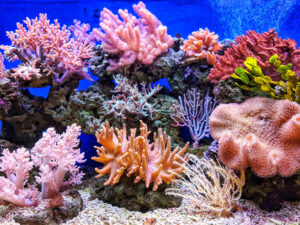10 Apr We Are Not Alone

Photo by QBaron on Unsplash
If you ever have a feeling of being all alone, know that this is far from true. Living inside every one of us is an entire ecosystem of intricately connected bacteria, viruses, fungi, and archaea. Heard of the first three, but not the fourth? It’s okay. There are many more creatures and morphons yet to be discovered that create our symbiotic partner, the microbiome.
Many people have likely heard of the microbiome as an important part of the gut, which is true. The microbiome covers us head to toe, inside and out. These smart bugs help us digest food. They create important neurotransmitters that take effect all over the body and in the brain. They can even modify our DNA… to their benefit, of course, and most of the time to ours as well.
Numbers help a concept. There are 10 trillion (approximately) cells in the human body. There are 100 trillion organisms in any one person’s microbiome. This manifests into 1.2 kilograms (over 2.5 pounds) of each person being comprised of bacteria. 1,000 grams of this mass colonize the gut or intestines. 20 grams, the vagina. 200 grams, the skin. 10 grams, the nose. And 20 grams, the mouth.
Your Microbiome
Imagine a coral reef. When first seen, it looks like a bunch of anemones and sponges and maybe some large fish swimming around it. As observation time increases, smaller fish, tiny holes in the coral, and smaller wiggly things become apparent. The more time spent studying, the more detail the reef reveals. All the creatures work together to survive in the ocean. Imagine your body covered inside and out with a coral reef. This is your microbiome.
What happens when the pH or temperature of the ocean changes? Or pollution gets dumped into the sea? The coral reefs die. Yes, the same happens when our microbiome is exposed to pH imbalance, non-nutritious dietary choices, stress (yes stress hormones create havoc) and antibiotics. The healthy microbiome succumbs to less friendly impostors. These con-artists do not help digestion optimally, they secrete unhealthy substances, and mutate DNA. Imbalance in the body takes hold and disease states begin to arise. Not just gastrointestinal diseases, but neurological, endocrine, autoimmune, cancers, and skin conditions can all be traced back to a suboptimal microbiome.
If right now you are on your knees begging for forgiveness for the burger and fries you had for dinner, the candy bar you had at Halloween or the scotch on the rocks that took things down a notch, do not beat yourself up. This just causes stress in the body. (Remember, stress promotes the bad actors.) Instead, love your body and consume lots of fresh organic fruits, vegetables, legumes and whole grains. These gifts from Mother Earth are exactly what our microbiome craves. The fiber and micronutrients in a plant-based diet feed the microbiome not only to sustain itself, but to also defend off the invaders. A healthy diet can help keep everything in check.
You may ask, “Why can’t I just buy a bottle of probiotics at the store and call it good?” It’s a question worth asking in today’s environment of supplements and quick fixes. Many of the probiotics on the shelves are already dead before taking them. The refrigerated types tend to be more bioactive. And even these expensive, refrigerated, high-maintenance bugs only make it into the upper part of the small intestines if they survive the high acidity of the stomach. To populate completely the 23 feet of small intestine, the nutrition consumed needs to be in food. Fruits and vegetables make it all the way through the large and small intestines delivering micronutrients, fiber and bacteria where they were meant to go. It’s part of the perfect plan and why humans evolved the way we did. From eating plants.
Tips for getting your microbiome back on track
Here are some helpful tips to get your microbiome back on track:
- If organic seems too expensive for you, look at The Environmental Working Group’s Dirty Dozen and Clean 15 lists.
- Get creative adding vegetables to everything: soups, burgers, salads, burritos, scrambled eggs, and grains or pasta.
- Remember to drink 2-3 liters of water daily (more if above ideal body weight) to help the nutrients get to where they need to go.
- Cook vegetables until the color becomes brilliant. This activates the availability of micronutrients in many foods.
- Get plenty of sleep. Remember you are sleeping for 100 trillion other than yourself.
In the words of Michael Pollan: Eat food. Not too much. Mostly plants.




